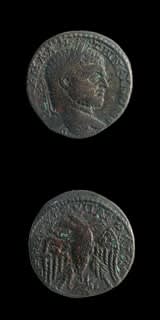Billon Tetradrachm of Emperor Caracalla, 211 CE - 217 CE
Billon
C.4260
Obverse: Laureate Bust of Caracalla Facing Righ Reverse: Eagle Standing Facing Forwards, Head to the Left, Holding a Wreath in its Beak, Star in Between Leg Caracalla was born April...
Obverse: Laureate Bust of Caracalla Facing Righ
Reverse: Eagle Standing Facing Forwards, Head to the Left, Holding a Wreath in its Beak, Star in Between Leg
Caracalla was born April 4,188 in Lyon, where his father, Septimius Severus, was serving as governor of the province of Gallia Lugdunensis under Emperor Commodus. His name was changed from Lucius Septimius Bassianus to Marcus Aurelius Antoninus at the age of seven. The name change was a way of connecting the family of Severus to that of the Antonines. The nickname Caracalla was taken from the name of a type of cloak popularized by the emperor, but this nickname, originally derisive, was never used officially. From the time of his name change to Antoninus, Caracalla was the designated heir of Severus. Less than three years later he was proclaimed emperor, officially joining his father as co-rulers of the empire. At the age of 14, he was married to the daughter of the praetorian prefect Plautianus, but the teenager despised his wife. The marriage ended less than three years later and there were no children. Upon his father’s death in 211, Caracalla ruled the empire jointly with his brother, Geta, until he was murdered later the same year, leaving Caracalla in sole control at the age of 23. The year 212 saw a flurry of administrative reforms under the young emperor's leadership. Soldiers received increases in pay and in legal rights, but the most noteworthy change was the bestowal of Roman citizenship upon all free residents of the empire. Construction was also well underway on the magnificent baths in Rome that would bear the emperor's name. In 217, Caracalla was assassinated on the road back from his military campaigns against the Partians in the east. Although Caracalla remains a rather dubious figure, historians often overlook the energetic, reformist and even intellectual character of Caracalla's reign. The changes brought about in the little more than five years of Caracalla's sole rule would have long-lasting implications throughout the empire for generations to come.
How many hands have touched a coin in your pocket or purse? What eras and lands have the coin traversed on its journey into our possession? As we reach into our pockets to pull out some change, we rarely hesitate to think of who might have touched the coin before us, or where the coin will venture to after it leaves our hands. More than money, coins are a symbol of the state that struck them, of a specific time and location, whether contemporary currencies or artifacts of a long forgotten empire. This stunning hand-struck coin reveals an expertise of craftsmanship and intricate sculptural detail that is often lacking in contemporary machine-made currencies. This ancient coin is a memorial an emperor’s reign passed from the hands of civilization to civilization, from generation to generation that still appears as vibrant today as the day it was struck.
Reverse: Eagle Standing Facing Forwards, Head to the Left, Holding a Wreath in its Beak, Star in Between Leg
Caracalla was born April 4,188 in Lyon, where his father, Septimius Severus, was serving as governor of the province of Gallia Lugdunensis under Emperor Commodus. His name was changed from Lucius Septimius Bassianus to Marcus Aurelius Antoninus at the age of seven. The name change was a way of connecting the family of Severus to that of the Antonines. The nickname Caracalla was taken from the name of a type of cloak popularized by the emperor, but this nickname, originally derisive, was never used officially. From the time of his name change to Antoninus, Caracalla was the designated heir of Severus. Less than three years later he was proclaimed emperor, officially joining his father as co-rulers of the empire. At the age of 14, he was married to the daughter of the praetorian prefect Plautianus, but the teenager despised his wife. The marriage ended less than three years later and there were no children. Upon his father’s death in 211, Caracalla ruled the empire jointly with his brother, Geta, until he was murdered later the same year, leaving Caracalla in sole control at the age of 23. The year 212 saw a flurry of administrative reforms under the young emperor's leadership. Soldiers received increases in pay and in legal rights, but the most noteworthy change was the bestowal of Roman citizenship upon all free residents of the empire. Construction was also well underway on the magnificent baths in Rome that would bear the emperor's name. In 217, Caracalla was assassinated on the road back from his military campaigns against the Partians in the east. Although Caracalla remains a rather dubious figure, historians often overlook the energetic, reformist and even intellectual character of Caracalla's reign. The changes brought about in the little more than five years of Caracalla's sole rule would have long-lasting implications throughout the empire for generations to come.
How many hands have touched a coin in your pocket or purse? What eras and lands have the coin traversed on its journey into our possession? As we reach into our pockets to pull out some change, we rarely hesitate to think of who might have touched the coin before us, or where the coin will venture to after it leaves our hands. More than money, coins are a symbol of the state that struck them, of a specific time and location, whether contemporary currencies or artifacts of a long forgotten empire. This stunning hand-struck coin reveals an expertise of craftsmanship and intricate sculptural detail that is often lacking in contemporary machine-made currencies. This ancient coin is a memorial an emperor’s reign passed from the hands of civilization to civilization, from generation to generation that still appears as vibrant today as the day it was struck.



